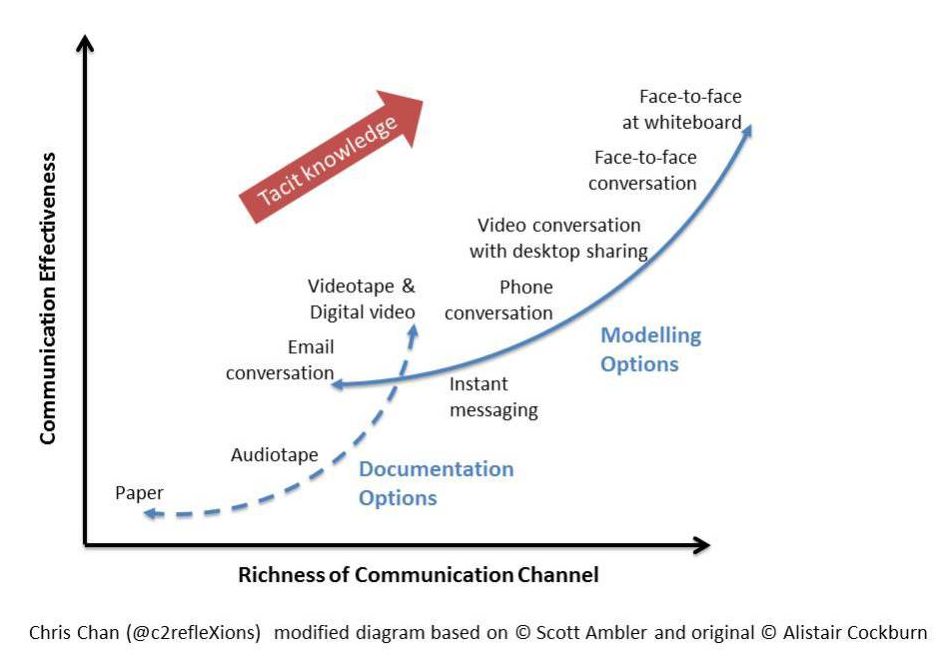News
View the latest inspiring and positive news and information about what's going on in the PM and IT world.

Date: 09/06/2021
Scrum is a framework that respects the 4 values and 12 principles of agility.
All agile frameworks insist that the best teams are those who work together, day today, in the same offices.
So how do you work with remote Scrum teams?
What happens if your Scrum team no longer works together physically?
Here are 5 tips to implement Scrum at distance:
 The most effective communication occurs face to face, in front of a whiteboard, for example, followed closely by, what might be surprising, video conversation with content sharing.
This means that from a distance, if all the participants in the video call agree to put on their camera and share their screen, for example, the communication is effective and everyone is part of the conversation.
It is possible to see the collaborators, to see if they are interrupted, if they need a break, to observe their attitude, their ability to listen, and to notice the level of understanding on elements visual and concrete.
Tip: You cannot force someone to put their camera on, but it is best to ask everyone to put it on, even if it means blurring or changing the background. We must therefore review together with the rules of exchange and communication by integrating the personal limits of each and the (new) tools.
The most effective communication occurs face to face, in front of a whiteboard, for example, followed closely by, what might be surprising, video conversation with content sharing.
This means that from a distance, if all the participants in the video call agree to put on their camera and share their screen, for example, the communication is effective and everyone is part of the conversation.
It is possible to see the collaborators, to see if they are interrupted, if they need a break, to observe their attitude, their ability to listen, and to notice the level of understanding on elements visual and concrete.
Tip: You cannot force someone to put their camera on, but it is best to ask everyone to put it on, even if it means blurring or changing the background. We must therefore review together with the rules of exchange and communication by integrating the personal limits of each and the (new) tools.
Damien Galzi
- Accept disruption and review the organization of work.
- Take inspiration from the Working Agreement Canvas.
- Ensure that communication is effective.
- Maintain ceremonies and select efficient tools.
- Unite and manage all teams.
1. Accept disruption and review the organization of work
First of all, you have to realize that working remotely is a real disruption in the way a team works. We must not say to ourselves:“We do as before but at home, we are used to working together, everything is going to be fine”.It is important to start from the start, whether it is the tools, the means of communication, or the rules of the game since remotely, the parameters and the availability differ. You have to deal with unforeseen events and personal obligations in addition to professional ones. We will therefore define the new rules of the game and seek to understand the new constraints and limitations of the team members. For example, remotely, it is likely:
- to be interrupted,
- to interfere in the privacy of employees,
- to have a connection or technical problems,
- to have to take care of the children,
- to have different rules to follow,
- to feel isolated,
- to have difficulty disconnecting from work.
- How are we going to organize the work?
- What are the new hours?
- What are the limits that should not be exceeded so as not to intrude into the privacy of employees?
- What are the (new) working tools?
- How are we going to communicate, discuss and continue to work TOGETHER?
How
- What are the new rules of the game?
- How can we work together despite the new context?
- What are the modalities, the new tools?
What
- What is visible?
- What should we build together?
- How do you make sure you have visibility on the increments to be made together?
2. Take inspiration from the Working Agreement Canvas
There is a Caneva on scruminc.com to help you, called the Working Agreement Canvas, which will facilitate the implementation of these new rules remotely. I advise everyone to complete it, even with a team that knows each other well. In particular, it includes the name of the team, the mission, the roles and responsibilities of each, but above all the standards and guides, which represent the code of conduct (e.g. no meeting after 5 p.m. because the children have returned from school. school). Tip: these things might seem simple and obvious, but this is something you should not take lightly. It should also be borne in mind that the rules must be adapted according to the number of Scrum teams.3. Ensure that communication is effective
Let’s take a closer look at the graph below, which shows the communication efficiency according to the communication channel. The most effective communication occurs face to face, in front of a whiteboard, for example, followed closely by, what might be surprising, video conversation with content sharing.
This means that from a distance, if all the participants in the video call agree to put on their camera and share their screen, for example, the communication is effective and everyone is part of the conversation.
It is possible to see the collaborators, to see if they are interrupted, if they need a break, to observe their attitude, their ability to listen, and to notice the level of understanding on elements visual and concrete.
Tip: You cannot force someone to put their camera on, but it is best to ask everyone to put it on, even if it means blurring or changing the background. We must therefore review together with the rules of exchange and communication by integrating the personal limits of each and the (new) tools.
The most effective communication occurs face to face, in front of a whiteboard, for example, followed closely by, what might be surprising, video conversation with content sharing.
This means that from a distance, if all the participants in the video call agree to put on their camera and share their screen, for example, the communication is effective and everyone is part of the conversation.
It is possible to see the collaborators, to see if they are interrupted, if they need a break, to observe their attitude, their ability to listen, and to notice the level of understanding on elements visual and concrete.
Tip: You cannot force someone to put their camera on, but it is best to ask everyone to put it on, even if it means blurring or changing the background. We must therefore review together with the rules of exchange and communication by integrating the personal limits of each and the (new) tools.
Maintain ceremonies and select efficient tools
In themselves, the ceremonies do not change, but you have to make sure you have the means and tools at a distance to replace the usual physical tools. In practice, Scrum teams are already well organized except for those that are not digitized at all. If this is the case, address the problem in the “how” part (eg: how to go from physical post-it to digital post-it?). Scrum does not advocate new rules for conducting remote meetings and usually advocates self-organization, always asking the right questions about their effectiveness. The ceremonies put in place are still relevant today, just because we are at a distance does not change. A daily Scrum is still a meeting but maybe with the camera and sharing the progress of the Trello kanban. The same is true for retrospectives and customer demonstrations. For the latter, it will be necessary to organize a specific point with the Scrum product owner (PO) in order to specify the “how”. If it is physical delivery, we will explain in the “how” all the precautions, rules, and health standards that this implies. If it is a remote delivery, it is also necessary to review the rules and provide the right support for the demonstration (webcam, slides, test environment, …) in order to have a fluid and efficient exchange while appreciating the reactions directly from the client, his attitudes and gestures. Tip: here is a non-exhaustive list of tools that can help you improve your Scrum ceremonies remotely: Trello, Miro, Klaxoon, Mentimeter, Mural, Kahoot, Jira, Wrike, Scrum Time, Slack, Team, Skype, Zoom, Discord, Meet, Spatial.io.Unite and manage all teams
Be careful to keep the work of the teams visible! What is recommended when the teams are remote is to make the product backlog as transparent as possible and also to ensure that all the teams have transverse visibility. All the product backlogs should be available through a common tool. The teams thus share a clear vision of current product developments and anticipate dependencies. When the company has many Scrum teams, or practices agility at scale, specific teams are formed to ensure clear management of the “how” and the “what”. By following the indications of the Scrum @ Scale Caneva for example, we take care to manage the responsibility for the “what” (product) and the “how” (process) through two dedicated teams. The goal is to eliminate unnecessary organizational conflicts that prevent teams from achieving their optimal productivity and optimizing collaborations. Tip: always keep a “lean” spirit by promoting the exchange around the added value of your practices with your teams. → Read Now: Onboarding new staff into your Agile team Agile coach for more than 5 years, Damien has supported companies in the development of their digital transformation projects, their continuous improvement initiatives and their search for the performance of R&D teams in a Lean and Agile spirit.
He is CSM, CSP, PMP, Lean 6 Sigma Green Belt and Agile Coach (TSP) certified.
Agile coach for more than 5 years, Damien has supported companies in the development of their digital transformation projects, their continuous improvement initiatives and their search for the performance of R&D teams in a Lean and Agile spirit.
He is CSM, CSP, PMP, Lean 6 Sigma Green Belt and Agile Coach (TSP) certified.
Date: 03/06/2021
ITIL is seen as a solution to many problems associated with IT organizations.
It is used as a guide to help groups improve the value of their services by focusing on co-creating business value and solving business problems, rather than just improving IT capabilities.
Organizations use ITIL as a framework for focusing all their activities, components, and resources to implement capabilities that deliver specific business value. So ITIL can benefit any organization that provides an IT service management product or service.
In this article, we provide seven key tips for organizations looking to effectively introduce the ITIL framework.
→ Download our free paper "The 7 ITIL Guiding Principles"
Read more
7 reasons to implement ITIL in your organization
Adopting ITIL 4 can bring many benefits to both organizations and their users. In the new version, the framework gives strategic importance to ITSM by placing it in the larger context of customer experience and shared value creation. The key benefits of ITIL4 are:- Cultural transformation
- Find a starting point
- Know the framework and define the roles
- Know where you want to go
- Know what to improve
- Integration of practices
- Continuous improvement
1. Cultural transformation
The first clarification to make concerns the terminology: ITIL cannot be “implemented” in the canonical sense of the term as it requires a cultural transformation to the approach to work. IT Service Management professionals need to help organizations in which they operate to shift their focus on customers, results, and business value so that they can make a deep connection between these factors. For this reason, we cannot simply speak of “implementing” ITIL, because this term implies the fact that there is a process with a beginning and an end. The ITIL framework is based on an approach to an iterative and incremental improvement and therefore requires a complete cultural transformation.2. Find a starting point
When introducing a new methodology, it is always necessary to take into account the organization’s past and current situation. Understanding what can and cannot be done and what has already been done in the past. It is important to see past results and to determine the objectives that are to be achieved. The main components of the Service Value System that must be implemented according to a holistic approach are the following:- Corporate Governance
- The flows of value
- The Practices
- Continuous Improvement
- The 7 Guiding Principles
3. Know the framework and define the roles
The knowledge and mastery of the concepts underlying the ITIL 4 framework is a factor that is as obvious as it is fundamental. Knowing the framework brings the knowledge of the need to clearly and unequivocally define the role each involved professional must play. The correlation between role definition and knowledge of the framework is a key factor to start with when adopting ITIL within an organization.4. Know where you want to go
ITIL helps to define the specific value flows of the organization and supports to concretely implement them through the 34 practices made available by the ITIL 4 framework. For this reason, it is necessary to thoroughly analyze roles, processes, information, and technologies, together with the ITIL 4 stakeholders. Stakeholders are included in order to define the future path to take towards the evolution of the organizational model. Clarifying the ins and outs of the organization makes it possible to identify possible weaknesses and opportunities in advance, by comparing the processes in place with best practices.5. Know what to improve
After analyzing the current situation, it is time to focus on the objectives; which value flows to introduce, and how to divide them into steps, actions, and tasks in such a way that they are easier to manage? Answering these questions will also allow us to answer a fundamental question: What is the motivation that drives the organization to introduce ITIL best practices? Once the answer to this simple but fundamental question has been found, the organization will be able to focus on the ITIL project. While also focusing on desired results (outcome) and those actually achieved (output).6. Integration of practices
Once the value flows have been defined with the relative steps required by the Demand for Value, it is necessary to identify the practices and associated resources that contribute to the success of each step. In the past, weaknesses often came to light precisely in the passage from the end of one process to the beginning of the next one. For this reason, using the Value Flows allows you to interface processes towards a shared and functional vision to also optimize procedural work and transition between processes.7. Continuous improvement
Having finally introduced ITIL into your organization does not at all mean that the process is over, quite the opposite!- Which processes have fully achieved the objectives?
- Which could be improved?
- Have the predetermined outcomes been obtained?

Date: 31/05/2021
“Is it possible to learn how to be better at managing change in an agile world?”
This was the question Melanie Franklin, renowned Agile & Change Management expert, transformed into an answer. In 2014 she published the book “Agile Change Management – a practical framework for successful change planning and implementation”.
The book provides an approach for managing transformational change initiatives, using a lot of the ideas from the agile methodologies. This book has led to the creation of the Agile Change Agent qualification.
Two years ago we had the opportunity to interview Melanie Franklin and today we are proud to announce the launch of the Agile Change Agent courses.
Read more
Agile Change Agent: an agile approach to change
An Agile approach to change is about doing change in waves of change. According to Melanie Franklin, Agile Change Management is about accepting that in this world of very fast-moving change, it is not a good idea to try and plan every single change detail upfront. The Agile Change Agent course & certification provides the participant with guidelines for those that want to work in a change. The course provides insight into how to plan and manage all the activities that are needed to design, deliver and adopt change in an Agile way. The course answers the question: “What makes a change successful?” “What is it that we really need to know to make a change successful?” “How can we manage our changes in an agile world?” It is not about what you have to do but how you are supposed to do it, the techniques you can use.Are you an Agile Change Agent?
You are a change agent if you are responsible for the creation of new ways of working as a result of a project investment. Or if you are in a change management role, where you are identifying what needs to be done by those who are going to have to work differently. But you are also a change agent if you are impacted by the change in sales, marketing, HR, finance, or other departments. You have daily priorities, you use existing ways of working to satisfy current customer demand and get the job done, but you are also mobilizing your colleagues and yourself to participate in the changes your organization makes/decides. So you are acting as a change agent. Understanding activities for effective change management and including them in your Agile project plan increases the chances that the deliverables from your project will be adopted as new business as usual working practices. People may not be called Change Agents but the point is that on top of their daily job they have a role to help make change happen and ultimately integrate change into the current ways of working.Why the Agile Change Agent course could be relevant for you?
- Agile and change explained on a practical level
- The course contains many problem-solving techniques
- You can benefit from a practical kit of techniques, checklists, and tools so you can start managing your change projects using what you have learned from the moment you leave the course
- The course helps those who know about change understand Agile, and those who know about Agile learn about change
- You can get a qualification on your CV that proves you have skills in Agile and Change Management - hitting the two hottest topics in business today.

Date: 26/05/2021
Scrum is a popular Agile Framework that helps teams function efficiently.
It does so through predefined roles that provide structure, while still allowing for flexibility.
Scrum is a framework that helps put the team into place and helps deliver works effectively.
Scrum provides a structure for meetings, responsibilities, and artifacts. The goal of the framework is to create a fundamental sense of structure underneath shifting skills and project needs. Scrum is pretty flexible and can be adapted to the situation of the company.
Read more
The Scrum Team
The dedicated Scrum roles are enough to describe the minimum responsibilities of the Scrum team. The size of the team and the specific skills depend on the project and the project phase, it can change over time. The predefined Scrum roles are the following:- the Scrum Product Owner,
- the Scrum Master,
- Scrum Developer(s),
- Stakeholders.
The Scrum Product Owner
The Scrum Product Owner is the professional responsible for maximizing the value of the product resulting from the work of the Development Team or, in other words, for maximizing business value for the project. He or she is responsible for articulating customer requirements and ensuring the business justification throughout the project. We can say this role embodies the voice of the Customer. The Product Owner must always maintain a dual view, understanding and supporting the needs and interests of all stakeholders, while also understanding the needs and workings of the Scrum Team. The Scrum Product Owner is, among other things, responsible for:- Managing the Scrum backlog,
- Managing Stakeholders,
- Managing releases.
The Scrum Master
The Scrum Master is the professional who coaches the team towards the adoption of the Scrum Framework. The core responsibility of a Scrum Master is to lead the Scrum Team to the correct understanding and enactment of the Scrum theory, practices, and rules. He/she is the professional responsible for ensuring that the Agile philosophy is understood and enabled inside the whole organization (that is the reason why is preferable that the Scrum Master belongs to the organization instead of being freelance). The main responsibility of the Scrum Master is being a process facilitator for the Product Owner and for all the Scrum Team. The Scrum Master is, among other things, responsible for:- Promoting values,
- Ensuring transparency,
- Enabling self-organization,
- Planning sprints.
The Scrum Developer
The Scrum Developer is the professional responsible for creating the project deliverables, together with the entire Development Team. The Development Team is made by professionals who do the work of delivering a potentially releasable increment of “Done” product at the end of each Sprint. Each Scrum Developer is responsible for delivering a functional element (or chunk) of the product at the end of each sprint. The Scrum Developer is also responsible for:- Delivering work,
- Estimating the user stories in the sprint backlog,
- Understanding the business requirements,
- Ensuring transparency,
- Being organized.
Stakeholders
The Stakeholders are not a direct part of the Scrum team but influence highly the course of events. The stakeholder has to keep a healthy relationship with the Scrum Product Owner to share the details of the project. The Stakeholder provides regular input to the Product Owner and prioritizes work effectively with the Product Owner, to ensure the project development. The Stakeholder in a Scrum Project is responsible for:- Regular input to queries of the Scrum Product Owner.
- Conveying his wishes and concerns with the Scrum Product Owner.
- Share all possible details with the Scrum Product Owner.

Date: 19/05/2021
In his previous interview (Using Best Practices in IT), Xavier Van Lindt explained how Best Practices prevent communication problems encountered by IT.
In this second article, Xavier presents how Best Practices help to avoid IT security problems.
Indeed, the second problem observed which joins the first point on the lack of communication is security.
Security is the result of effective communication between business management and IT.
IT security is only in alignment with the security needs mentioned by the business. Here too, the impact is spread over the 3 hierarchical levels of the company (strategic/tactical/operational). It is therefore governance that will make it possible to know what the needs and requirements of the businesses are with regard to security.
Several Best Practices address the topic of IT security. In the ITIL 4 framework, security is studied in the strategic modules ITIL Direct Plan and Improve and ITIL Leader Digital & IT Strategy. In DevOps, there is a module dedicated to security, which is one of its fundamental principles, DevSecOps.
Contrary to popular belief, IT security is not just a design concern. It is not enough to put passwords, firewalls, or ISPs. DevOps modules teach that security is present in everyday life when you are in the RUN (production).
During a run, the overarching concept of safety is called observability.
It is often forgotten that it is essential to observe everything that is happening in order not to miss anything in terms of safety. IT Security is not just about hacking, phishing, or spamming. IT Security is also about the availability of data, in addition to confidentiality and integrity.
DevOps, through its SRE, Continuous Delivery, and DevSecOps modules, focuses on measuring everything that happens in production to be sure to guarantee availability.
 Xavier is Senior Consultant and accredited trainer ITIL 4 Foundation & Intermediate, ITIL v3 Foundation, Practitioner & Intermediate, ITIL MALC, ITIL Expert, DevOps Foundation, ISO20000 Foundation, Lean IT Foundation, Lean, Kaizen, Scrum Master, DevOps Leader, DevOps SRE, DevOps continuous delivery, Integrated Service Management (ISM).
Xavier is Senior Consultant and accredited trainer ITIL 4 Foundation & Intermediate, ITIL v3 Foundation, Practitioner & Intermediate, ITIL MALC, ITIL Expert, DevOps Foundation, ISO20000 Foundation, Lean IT Foundation, Lean, Kaizen, Scrum Master, DevOps Leader, DevOps SRE, DevOps continuous delivery, Integrated Service Management (ISM).
Read more
IT security incorporated in Best Practices
The master benchmark for security remains the ISO 27000 series. ITIL mentions security as a practice, but DevOps, in a very operational way, focuses on observability and culture. In DevOps Foundation and DevSecOps security is not just the role of the CISO but the concern of ALL members of the organiSation, which makes it a cultural phenomenon. Safety is not technical, it is above all cultural and comes from the profession. Everyone needs to be involved, which is well mentioned by DevOps. Thus, what we will expect from the CISO (Chief information security officer) is not simply to evoke security policies (as mentioned in the ITIL 4 training) but also an evangelization of the entire IT department. As well as of users and customers at the level of different security aspects (strategic or operational tactics). Safety is everywhere and concerns everyone. Since security is not just a matter of politics, mechanisms or systems must be designed, tested, and supervised in operation. In order to keep Safety in line, we must communicate! There are 5 universal concepts found in DevOps, ISO, and ITIL repositories, to protect the information the organization needs to run its business:- Confidentiality: access to data limited to authorized persons
- Integrity: accuracy throughout the system
- Availability: data available when, where, and for whom.
- Authentication: ensure the identity of the requester
- Non-repudiation: being able to prove the action carried out.
Xavier van Lindt
 Xavier is Senior Consultant and accredited trainer ITIL 4 Foundation & Intermediate, ITIL v3 Foundation, Practitioner & Intermediate, ITIL MALC, ITIL Expert, DevOps Foundation, ISO20000 Foundation, Lean IT Foundation, Lean, Kaizen, Scrum Master, DevOps Leader, DevOps SRE, DevOps continuous delivery, Integrated Service Management (ISM).
Xavier is Senior Consultant and accredited trainer ITIL 4 Foundation & Intermediate, ITIL v3 Foundation, Practitioner & Intermediate, ITIL MALC, ITIL Expert, DevOps Foundation, ISO20000 Foundation, Lean IT Foundation, Lean, Kaizen, Scrum Master, DevOps Leader, DevOps SRE, DevOps continuous delivery, Integrated Service Management (ISM).
Date: 12/05/2021
Hospitals are going through a period of change and reform, facing the challenging task of delivering transformation while protecting quality, the effective use of resources, and continuing productivity.
This change is unrelated to the current situation regarding Covid-19.
The hospital sector shared its need for a framework to manage and control the delivery of change across the portfolio, program, and project management. The aim is to build its capabilities to manage the implementation of transformation objectives both effectively and efficiently.
(Figures provided by the Swiss Federal Statistical Office https://www.bfs.admin.ch/bfs/en/home/statistics/health.html)
These statistics underscore how much work is required in healthcare project management to continuously improve operations in such a large industry. Healthcare costs in Switzerland amount to 11.7% of GDP, making it the second-highest in Europe.
In the 2018 Euro Health Consumer Index survey, Switzerland was ranked first and described as having an excellent healthcare system. For this reason, healthcare project management has become even more important in recent years.
This is largely due to safety concerns: an ineffectively managed healthcare project can lead to patient health problems.
Read more
Why Is Project Management Important in Healthcare?
A number of statistics show the enormous size of the healthcare industry and its impact on the overall Swiss economy.| Factor | Percentage |
|---|---|
| The health of the population aged 15 and over in private households in % (2017): Permanent health problem | 32,7 |
| The hospitalization rate for 1000 inhabitants (2019) | 118,3 |
| Rate of use of home care for persons ≥ 80 years, in % (2019) | 29,2 |
| Number of hospital beds/1000 inhabitants | 4.8 |
| Number of doctors in the outpatient sector/1000,000 inhabitants | 222,3 |
Challenges Of Healthcare Project Management
Project management in healthcare is distinct because it takes complexity and risk to a whole new level. Here are some of the primary reasons it’s different than other industries:- Funding and Optimization
- Quality and Efficiency
- High Discipline Diversity
- Lack of Skilled Resources
- Deficient Change Methodology
1. Funding and Optimization
Project management aligns money with activity. It ensures you have the funding for your efforts at various stages of a project. To derive the greatest benefit from the available finance the project must be optimized, which means allocating exactly the right amount of space towards, operating theatres, diagnostic suites, public areas, and other facilities to design the most cost-efficient arrangement.2. Quality and Efficiency
The cost-reducing force of managed care has galvanized numerous mergers and acquisitions in the hospital and medical group sectors in an attempt to gain economies of scale and offer a more economically attractive service. There are harsher and more serious ramifications if projects go over budget or off schedule because patients’ well-being may be at stake. Any mistake or lack of process can have a detrimental effect on patients. Quality control is a major part of project management: in healthcare, all opportunities should be considered for efficiency from the project’s inception. This includes ensuring that the architectural and engineering designs are aligned to the budgetary and functional goals of the project. The increased demand for healthcare combined with rising costs has put more pressure on the industry to deliver economical, high-quality services. Trying to find the balance between efficiency and quality places even more importance on the need for better project management.3. High Discipline Diversity
High-technology care is provided by very specialized health care professionals. Teams of multiple disciplines, especially if they have not worked together before, are likely to lack a common language. People from the same discipline share a common meaning for the words they use and understand each other. But, when a number of disciplines are involved—surgery, physical therapy, social work, nursing—people may use the same words and incorrectly assume they mean the same to everyone around the table. In communication terms, what occurs is the erroneous translation: a person from one discipline encodes a meaning for a term but someone from a different discipline decodes a different meaning. As a result, the message is not understood. This is particularly difficult to address in the health care team because of the apparent simplicity of the terminology. Perhaps the safest assumption the project leader can make at the start of the effort is that people from different disciplines do not understand each other and that giving and receiving feedback is crucial. Asking apparently obvious questions can be very useful until a common language is achieved within the team. The project manager must ensure that team members overcome their functional unfamiliarity and have to confront the skepticism and suspicion between functions before the team can work effectively.4. Lack of Skilled Resources
As health care’s landscape changes, so do the type of resources required on successful projects. The current trend of adopting the Project Management Office (PMO) framework does not always equate to the ability to successfully lead multi-organization projects, work side by side with clinicians to change care delivery, or assess the impact of a significant regulation. A project team without the necessary skills and experiences, including health care industry expertise, will ultimately fail. → Read more about the setup of a PMO in the hospital sector in this interview.5. Deficient Change Methodology
The pressure to change rapidly is especially palpable in health care, as organizations that historically ‘grew into’ change now must employ change methodology to be successful. Often, projects do not include a workstream dedicated to preparing the organization for significant change. Change communication is particularly challenging due to the political dichotomy between physicians and administration. The result is a lack of understanding, acceptance, and ultimately adoption of the change, leading to failed project outcomes. A range of other issues is affecting the evolving industry — issues for which project management is increasingly vital. These issues include the following:- Decreasing payments from government health programs and private insurance companies have compelled healthcare organizations to find ways to save money.
- New and complicated systems for electronic health records on patients need continual monitoring and improvement.
- New technologies also need tracking and improvement.
- New regulations continue to emerge.
- There is greater scrutiny from outside groups, including the government, health insurance companies, and patients.
Benefits of Healthcare Project Management
Strong project management helps improve healthcare and the healthcare industry in a number of ways. Project management can do the following:Ensure
- that the technical composition of the project team is based on the project objective. If the objective is to reduce costs, ensure that all members are knowledgeable about cost measurement and accounting.
- that team members are at a high enough level in their respective organizations that recommendations have a high probability of being implemented.
- that the politics of integration are not underestimated. Only when team members appreciate that all stand or fall together can the actual project work begin.
- that team members genuinely relate to each other as peers. Hierarchy must not interfere with the peer relationships of the team. The person(s) who directs the team in solving a particular problem should be that member with the relevant knowledge and experience, rather than the person at the top of the implicit hierarchy.
Improve
- the quality of care by improving processes used to provide that care.
- communication among healthcare staff caring for patients.
- organizational planning.
- budgeting, as strong project management directly aligns resources with important work.
- processes that are established to decrease the risk of lawsuits — in large part because improved processes increase the quality of care.
- relations with stakeholders, including insurance providers, government agencies, patients, and others.
- staff productivity.
- the mitigation of the risk and prevent legal issues from arising.







